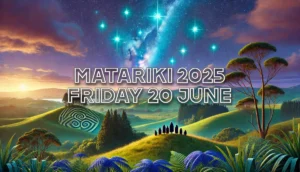Manawatia a Matariki : Reviving the Ancient Traditions of the Māori New Year
Embracing the Resurgence of Matariki as a Cultural Celebration in Aotearoa
In the starry expanse of the southern hemisphere, a cluster of stars known as Matariki emerges, marking the beginning of the Māori New Year. For centuries, this celestial event has held great significance for the indigenous Māori people of Aotearoa (New Zealand), symbolizing renewal, reflection, and community. In recent years, a cultural renaissance has sparked a renewed interest in Manawatia a Matariki, reviving ancient traditions and bringing communities together to honor this celestial phenomenon.
Manawatia a Matariki :
The Significance of Manawatia a Matariki
Matariki, also known as the Pleiades star cluster, rises in the pre-dawn sky during the winter months of the Southern Hemisphere, typically between late May and early June. Māori traditions hold that when the seven stars of Matariki are visible, it is time to celebrate the harvest, remember loved ones who have passed, and prepare for the year ahead. The stars themselves are associated with different aspects of life, including health, prosperity, and the environment.
Reviving Ancient Traditions of Manawatia a Matariki:
While the celebration of Matariki has always held deep cultural importance within Māori communities, its significance had somewhat waned over time. However, in recent years, there has been a resurgence of interest and a reclaiming of this tradition as a vital part of New Zealand’s cultural heritage. This revival has been driven by a desire to reconnect with ancestral wisdom, foster a sense of belonging, and ensure the preservation of Māori customs for future generations.

Community Gatherings and Festivities:
Across Aotearoa, communities now come together to honor Matariki through a variety of events and festivities. These gatherings often feature kai (traditional food), waiata (songs), haka (war dances), and storytelling, creating a rich tapestry of cultural expressions. Art exhibitions, workshops, and performances also provide spaces for creativity and learning, allowing individuals from all backgrounds to engage with Māori culture and traditions.
Embracing the Spirit of Matariki: A Tapestry of Cultural Celebrations Across Aotearoa
As the Matariki star cluster graces the skies of Aotearoa, communities throughout New Zealand come alive with vibrant celebrations, uniting to pay homage to this sacred time. These gatherings offer a mosaic of cultural expressions, as people engage in diverse activities, from indulging in traditional kai to showcasing mesmerizing haka performances. The celebration of Matariki has become a testament to the rich tapestry of Māori culture, bringing people from all backgrounds together to learn, appreciate, and honor this significant annual event.
Kai: Nourishing the Body and Soul:
Matariki celebrations are incomplete without the presence of kai, the traditional food that symbolizes sustenance and abundance. Communities gather to share in feasts that highlight indigenous ingredients and preparation methods, providing a taste of Māori culinary heritage. From earthy kūmara (sweet potatoes) to succulent seafood, these meals not only nourish the body but also serve as a reminder of the deep connection between land, sea, and culture.
Waiata and Haka: Harmonies of the Heart:
In the spirit of Matariki, waiata (songs) and haka (war dances) fill the air, resonating with ancestral voices and invoking a sense of unity and pride. Māori performers, both young and old, come forward to showcase their talents, expressing their cultural identity through melodic tunes and powerful movements. These performances captivate audiences, evoking emotions and fostering a deeper appreciation for the beauty and significance of Māori art forms.
Storytelling: Weaving Narratives of the Past:
Matariki celebrations are an opportune time for the sharing of stories, myths, and legends, providing a gateway into the rich tapestry of Māori history and wisdom. Elders and knowledge holders take center stage, passing down ancestral knowledge to younger generations through captivating narratives. These stories not only entertain but also educate, instilling a sense of identity, heritage, and values within the community.
Art Exhibitions, Workshops, and Performances: A Creative Exploration:
Matariki festivities go beyond traditional practices, embracing contemporary art, workshops, and performances. Art exhibitions featuring Māori artists offer a glimpse into the vibrant expressions of modern Māori culture, showcasing works inspired by Matariki and its themes. Workshops and interactive sessions provide opportunities for people of all backgrounds to engage in hands-on learning, from traditional weaving to learning Māori greetings and songs. Performances ranging from theater to contemporary dance celebrate the fusion of Māori traditions with contemporary artistic expressions.
Educational Significance of Manawatia a Matariki
Manawatia a Matariki resurgence has extended beyond community celebrations to reach educational institutions throughout New Zealand. Schools now incorporate Matariki into their curricula, providing students with a deeper understanding of Māori culture, history, and traditions. Through learning about Matariki, young New Zealanders gain an appreciation for the country’s indigenous roots and develop a stronger sense of identity and belonging.
Environmental Awareness and Sustainability:
Manawatia a Matariki is not only a time of reflection and celebration but also a reminder of the interconnectedness between humans and the natural world. The celebration of Matariki often includes activities focused on environmental awareness and sustainability. Planting native trees, cleaning up rivers, and learning about traditional Māori practices of land and resource stewardship are all ways in which Matariki fosters a sense of responsibility towards the environment.
Looking Towards the Future:
As Manawatia a Matariki gains momentum, its impact extends beyond New Zealand’s shores. The revitalization of this ancient tradition serves as a powerful example of cultural resurgence and preservation. The increasing awareness and appreciation of Matariki within New Zealand and beyond contribute to a more inclusive and diverse society, one that values and respects indigenous knowledge and customs.
Unveiling the Mysteries of Matariki: Exploring 3 Common FAQs
What does Manawatia a Matariki mean?
Manawatia a Matariki translates to “Celebrate Matariki” in English. It is an invitation and a call to honor and acknowledge the significance of Matariki, the Māori New Year. The phrase encompasses the idea of actively engaging with Matariki, its traditions, and its cultural importance.
What is the greeting for Matariki?
The traditional greeting for Matariki is “Ngā mihi o Matariki,” which translates to “Greetings of Matariki” in English. This greeting is used to acknowledge the arrival of the Māori New Year and to express well wishes and blessings for the year ahead.
What does Mata Ariki mean?
Mata Ariki is a term that is closely related to Matariki. It translates to “Eyes of God” or “Eyes of the Chief” in English. Mata Ariki refers specifically to the brightest star within the Matariki star cluster, known as “Tupu-ā-nuku” or “Alcyone” in Western astronomy. This star holds special significance and is often regarded as a guiding star or a representation of leadership and wisdom.
What are the names of the 7 Matariki stars?
The Matariki star cluster consists of seven main stars, each with its own unique name and symbolism. The names of the seven Matariki stars are:
- Tupu-ā-nuku (Alcyone): Representing food grown in the ground and associated with fertility and sustenance.
- Tupu-ā-rangi (Pleione): Associated with the growth of crops and signifies the connection between the earth and the heavens.
- Waipuna-ā-rangi (Electra): Symbolizing the importance of freshwater and its role in sustaining life.
- Waitī (Taygeta): Associated with all freshwater creatures and highlighting the significance of water ecosystems.
- Waitā (Maia): Symbolizing the gentle rain and its importance in nurturing the land.
- Waipuna-ā-rangi (Merope): Representing the connection between water and the spiritual realm.
- Ururangi (Atlas): Symbolizing the winds and their role in guiding and shaping the environment.
These seven stars hold deep cultural significance for the Māori people, with each star representing different aspects of the natural and spiritual world, guiding their understanding of the Māori New Year and its associated traditions.
Manawatia a Matariki, the resurgence of Matariki as a cultural celebration, has become a beacon of cultural revitalization and community unity in Aotearoa. By embracing this ancient tradition, New Zealanders are reconnecting with their roots, fostering cultural pride, and cultivating a more profound appreciation for the wisdom and
heritage of the Māori people. As Matariki rises each year, so too does the spirit of unity, reflection, and celebration, illuminating the path toward a more inclusive and culturally vibrant future for all.


